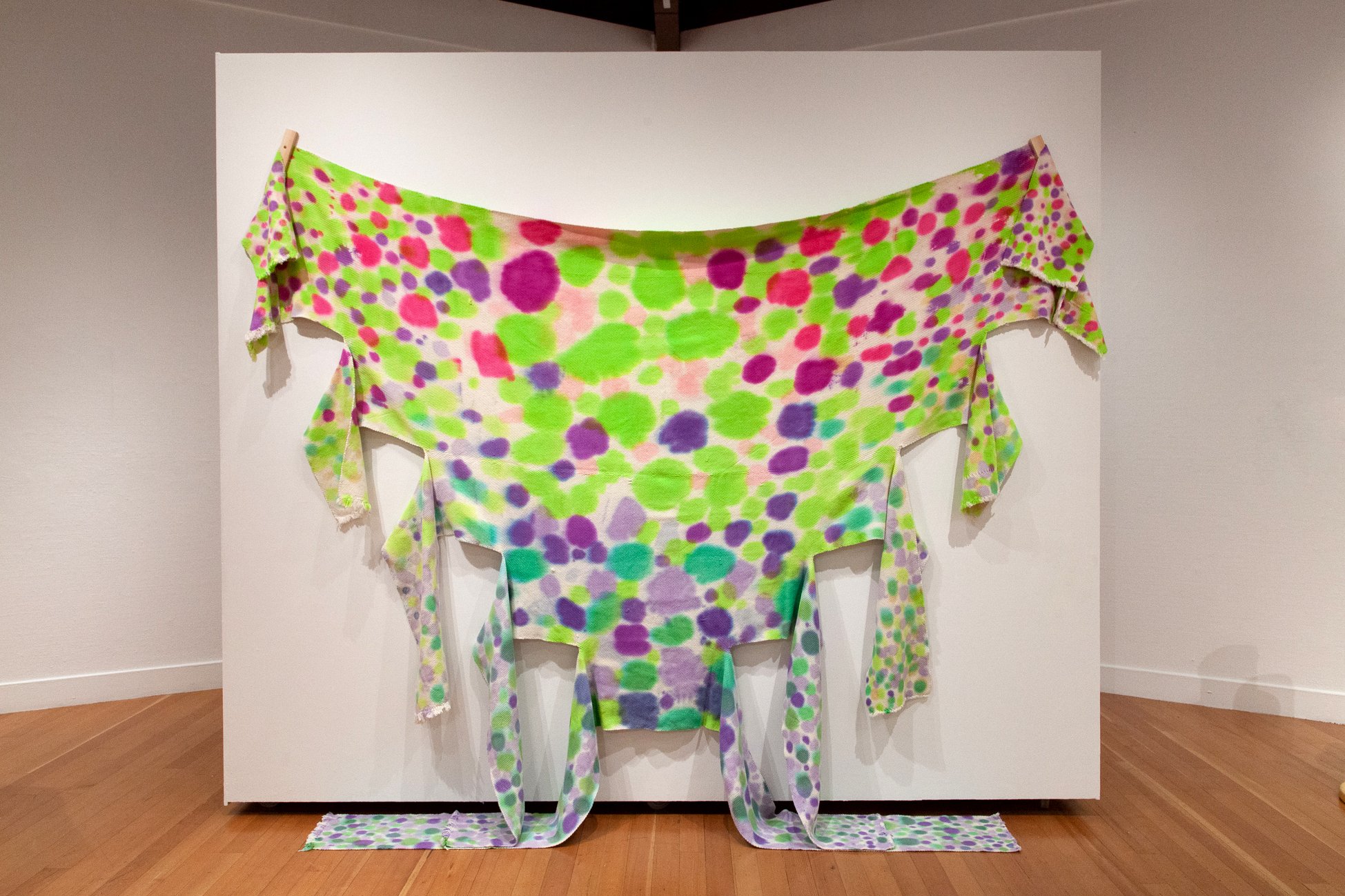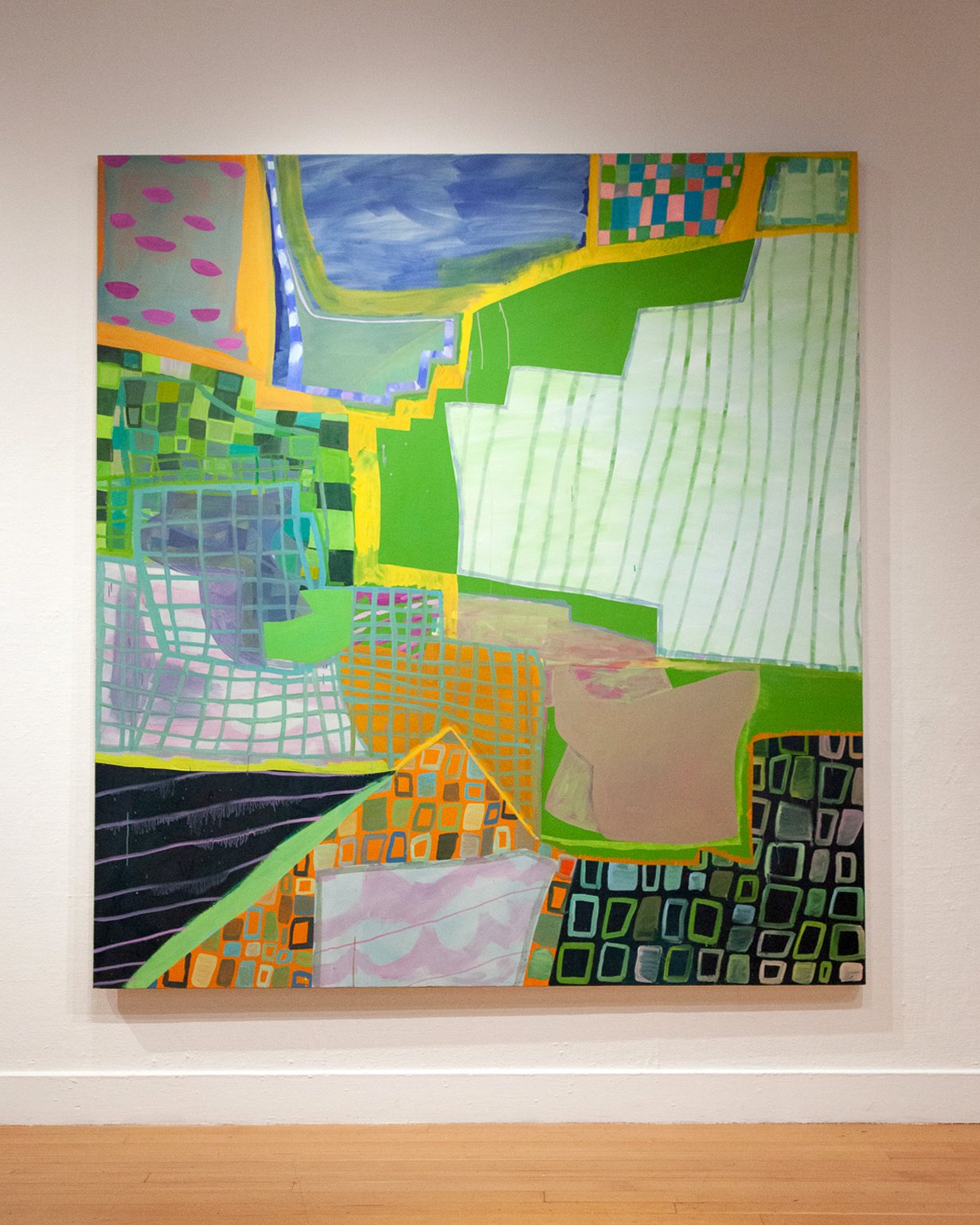MIDAS: How Art Becomes Life & Life Becomes Art
January 29 – March 26, 2022
Ricki Dwyer, Linda Geary, Maria A. Guzmán Capron, Sahar Khoury, Jerry Leisure, Kyle Lypka & Tyler Cross, John Moore
Curated by Squeak Carnwath
Artist & Curator Bios
Faces, flowers, fabrics are alchemically transformed at Berkeley Art Center by Jaimie Baron, Berkeleyside
THE INSIDE TRACK
by Julia Couzens
Invisible attachments — those subliminal connections, like hidden organs, that nourish the artist’s daily effort and interior life — are what Midas: How Art Becomes Life & Life Becomes Art examines and celebrates. Curated by artist SQUEAK CARNWATH, the exhibition features objects of inspiration and remnants from each artist’s studio alongside finished works.
Artists work for many reasons: cultural critique, social activism, money, professional ambition, and sheer habit are just some of the motives that induce an artist into the studio. But the visceral, nameless need to work is the most urgent and sustaining reason. Thunderbolts of inspiration are for Marvel Comics and the movies. Artists know that it’s work that generates work. They know that moves generate moves. There’s nothing woo-woo or glamorous about it. But moves that surrender to mystery and the laws of sensitivity are the ones that most richly invigorate the creative process.
RICKI DWYER
RICKI DWYER’s 10-year relationship with the loom has been encoded by the body with an emotional temperament that carries over into all the ways he engages with the world. Inserted into the ancestry of skilled labor, manual dexterity, and the spirituality of world-building, being a weaver has allowed his own identity construction to be understood through the fluid and contextually determined material of cloth. He honors drapery as the negotiation that things will never fall the same way twice.
Ricki Dwyer, Conditions of Consciousness Formation, 2020, installation view. Courtesy of the artist.
Ricki Dwyer, Conditions of Consciousness Formation, 2020, installation view. Courtesy of the artist.
Ricki Dwyer, Untitled (purples + greens weaving) 2021, After Morris, 2022. Courtesy of the artist.
LINDA GEARY
LINDA GEARY’s work is inspired by material processes of cutting, revision and repair. She uses collage and other approaches that reference actions of sewing and construction, modes of working that sometimes exist outside of the patriarchal history of painting, and more akin to laying a path of stones or making a quilt. Other parts of the process involve erasure, invisibility and camouflage. Textiles provide an alphabet of shape, color and pattern that she works with in order to let the work “fall apart” in order to experiment with different ways of putting it back together.
Linda Geary, Flower Power 2, 2020–21. Courtesy of the artist and Gallery 16, San Francisco.
Linda Geary, And a little more about how to get back, 2021–22. Courtesy of the artist and Gallery 16, San Francisco.
Linda Geary, Flower Power 2 (detail)
Linda Geary, And a little bit more about how to get back (detail)
Linda Geary, wood stool, red chair, yellow chair
Maria A. Guzmán Capron
Through a combination of hand-sewn textiles and paints, MARIA A. GUZMÁN CAPRON joins together an array of patterns and striking colors to fashion bodily forms. Merging figuration with abstraction, her works explore cultural hybridity, pride, and the competing desires to assimilate and to be seen.
Maria A. Guzmán Capron, Caracol (detail), 2020. Courtesy of the artist and Shulamit Nazarian, Los Angeles.
Maria A. Guzmán Capron, Reflection, 2017. Courtesy of the artist and Shulamit Nazarian, Los Angeles.
Maria A. Guzmán Capron, Bolsa, 2021. Courtesy of the artist and Shulamit Nazarian, Los Angeles.
Maria A. Guzmán Capron, ceramic shell vases with unfinished soft sculpture
Sahar Khoury
SAHAR KHOURY makes sculptures that integrate abstraction, personal and political symbols, and an intuitive sensitivity to site. Found or rejected objects that are immediate, abundant, and recurring serve as a script for constructions made of metal, clay, cement, and papier-mâché. Trained as an anthropologist and having never taken any fundamental art classes, Khoury continues to develop an idiosyncratic approach to merging diverse materials, with a primary commitment to spontaneity versus perfection.
Sahar Khoury, Untitled (palm trees in Haiti) and Untitled (palm trees in Iraq), installation view
Sahar Khoury, Untitled (palm trees in Haiti) (left) and Untitled (palm trees in Iraq) (right), both 2021. Courtesy of the artist and Rebecca Camacho Presents, San Francisco.
Sahar Khoury, Untitled (palm trees in Iraq) (detail), 2021. Courtesy of the artist and Rebecca Camacho Presents, San Francisco.
Sahar Khoury, altered wooden chair with umbrella to shade Esther from the sun
Jerry Leisure
JERRY LEISURE makes polychromed wood sculptures using traditional techniques. He sees the pieces as small meditations that combine whimsy with serious intent. He believes an art object can pass on the contemplative aspects of its making and that it doesn’t have to speak a particular language to have effect.
Jerry Leisure, installation view. All works courtesy of the artist.
Jerry Leisure, The Edge of Earth, 1993. Courtesy of the artist.
Jerry Leisure, cannonball (circa 1600s–1700s) and measuring stick
Kyle Lypka & Tyler Cross
The artistic duo of KYLE LYPKA and TYLER CROSS explore relationship and collaboration using glazed ceramic, cast aluminum, and mixed media sculptures. Recent work includes overt references to the human form combined with material experimentation in the hyper-glazed finishes of their sculptures.
Kyle Lypka and Tyler Cross, Lodestone, 2020. Courtesy of the artists and pt. 2 gallery, Oakland. Photo by pt. gallery
Kyle Lypka & Tyler Cross, Lodestone (detail), 2020.
Kyle Lypka & Tyler Cross, hand-built shelves with glaze tests and maquettes
John Moore
A prolific artist who eschews the gallery system, JOHN MOORE rarely shows his work publicly. Over decades, he has transformed his North Oakland home and studio into a living museum filled with original paintings, collages, drawings, and sculpture. Every wall, shelf, tabletop, and countertop is carefully curated with handmade artworks, objects, and curios from a life dedicated to the role of art in one’s daily life.
John Moore, paintings and works on paper with table made from aluminum cans, installation view. All works courtesy of the artist.
John Moore, installation view (detail)
John Moore, installation view (detail)
Photos by Gazelle Samizay unless otherwise noted.




























